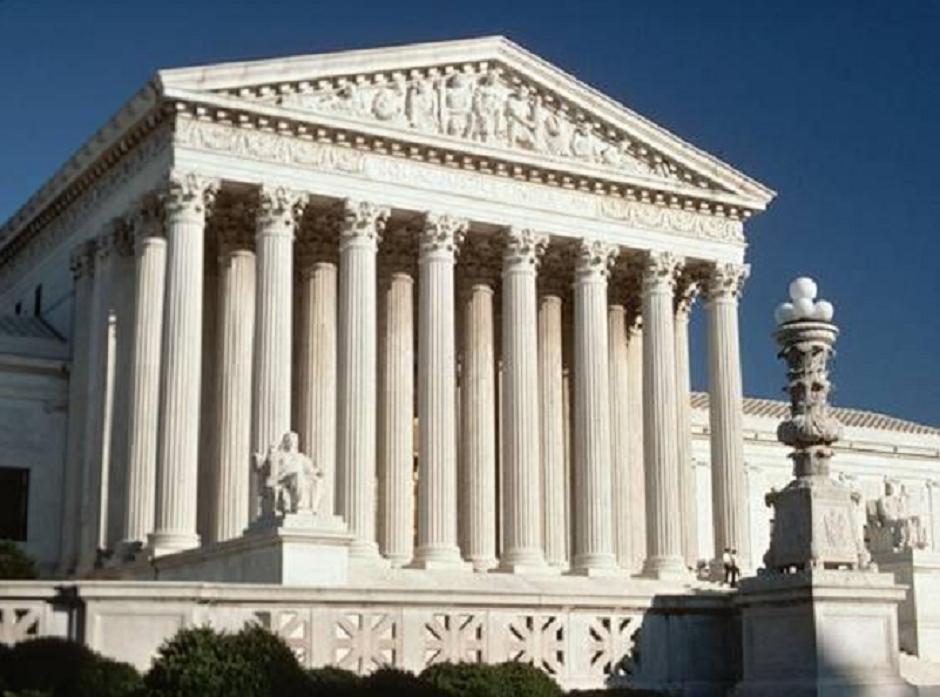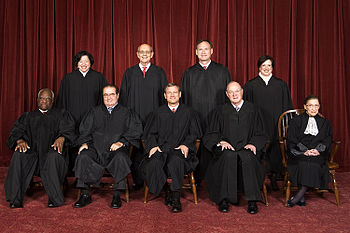 | (Left: The Supreme court building of the United States) (Below: The nine Jusitices of the Supreme Court)  |
The Judicial Branch
The Organization of the System
DISTRICT COURTS: The lowest level of the federal court system are district courts. In total there are 91 district court buildings in the United States of America. By law there must be at least one district court in each state. Wisconsin actually has three district courts located in Milwaukee, Madison and Green Bay. A district court is the only federal court in which a jury is impaneled to help rule on cases. It is a good thing too, as the district courts hear over 300,000 cases a year. In fact in 2008 district courts heard as many as 338,000 cases. It is in district courts that there is original jurisdiction. This means that the courts don't hear appeals but that they are the entry point for many cases. The cases that a district court will hear revolve around one of the following subjects, Federal Crimes (such as embezzlement or large tax fraud), Civil suits under federal law (such as filing a lawsuit for wrongful death), Civil suits between citizens of different states where the amount exceeds $75,000 (an example would be a Wisconsinite suing a Missourian for killing their child by negligence), Supervision of Bankruptcy provisions (if a business has to file for chapter 11 bankruptcy, a district court will often oversee the case.), review of actions of other federal agencies (the court might look after the FBI to see if all correct procedures are being followed), admiralty and maritime laws (involves cases revolving around ships and international waters), and supervision of naturalization of aliens. In total there are 91 district court buildings in the United States of America.
THE COURTS OF APPEAL: Appellate courts (courts of appeal) are fewer in number than district courts. In fact throughout the entire nation there are only 12 appellate courts. The task of the appellate court is to review the decisions made by lower level courts (district courts) and find out whether the rulings are legal. For instance, if a case reaches an appellate court is because the trial in the lower level courts was run incorrectly. Maybe the judge allowed invalid evidence, or the jury was partial. There are a number of violations that would be grounds to have a cases retried. It is the job of the appellate courts to review and see if those violations occurred or if the trial was fair. If the appellate courts review a case and rule that the lower courts had indeed violated correct procedure then the case will be retried. If the appellate courts find no evidence of courtroom violations, the original ruling of the lower courts is validated and upheld.
THE SUPREME COURT: The Supreme Court is the highest and most powerful court in the United States justice system. The Supreme Court has both the power of original jurisdiction and appellate jurisdiction. This means that the Supreme Court can hear original cases and also determine if a mistake has been made in a lower level court. The Supreme Court is made up of nine justices, eight associates and one chief. The current members of the supreme court bench are Antonin Scalia, Anthony Kennedy, Clarence Thomas, Ruth Bader Ginsburg, Stephen Breyer, John G. Roberts, Samuel A. Alito, Jr, Sonia Sotomayor,Elena Kagan. Once appointed to the Supreme Court bench, a justice is there for life and can only be removed though the process of impeachment. This makes the position of Supreme Court justice one of the most desired in the entire justice system, if not in all of politics. A new justice may only be appointed to the bench by recommendation of the president and verification by congress. The great power that the Supreme Court possesses is that its rulings are final and serve as a bench mark around the country. This means that when the Supreme Court ruled to end segregation in public schools (Brown v. Board of education), that became the law of the land. The entire nation had to follow that ruling and desegregate their schools, even if some states were reluctant to. This case for all rulings, it is the reason if you are arrested in the United States an Officer must read you your Miranda rights (Miranda v. Arizona).
Famous Cases?
Every single decision the Supreme Court makes is of extreme importance to your life and to your rights as a citizen of the United States. In the history of the court there have been many controversial decisions that have received a great amount of press. Click on the case that you want to learn more about.
Roe v. Wade (Supreme Court decision on the right of abortion choice.)
Citizens United v. Federal Election Commission (The reason that you see so many television ads during the election cycles.)
National Federation of Independent Business v. Kathleen Sebelius, Secretary of Health and Human Services (The Supreme Court decision that upheld Obama care.
(Miranda v. Arizona). (The reason if you are arrested in the United States an Officer must read you your Miranda rights)
(Brown v. Board of education), (The Supreme Court ruled to end segregation in public schools)
Gideon v. Wainwright (A defendant in the United States justice system must have the right to a legal counsel.
Types of Cases
So what types of cases make it into the Supreme Court?
A court case can be broken down into either a criminal case or a civil case. A criminal case is a case in which there defendant has allegedly committed a crime. A Civil case is a case in which the plaintiff (the person initiating the case) is seeking legislation.
The Supreme Court is unique from other federal courts in the American justice system in the fact that it is allowed to select which cases it wants to hear. It takes only four out of the nine justices to agree to hear a case before it reaches the Supreme Court. Some criteria that help determine which cases reach the Supreme Court are:
1. Whether or not the case conflicts with a previous Supreme Court decision. For example in the case of Brown V board of education the ruling of separate but unequal is inherently unequal reversed their previous ruling in Plessey v Fergusson which allowed for segregation.
2. If the case has historical significance the Supreme Court likes to hear cases on hot topics that are very controversial, and set a precedent for all lower courts to follow. For example if a case on legalizing marijuana usage around the country was coming up the United States Supreme Court might look into hearing it because a ruling on the legalization of marijuana would affect many Americans and is controversial.
3. A third aspect that helps a case get heard is if lower courts have conflicting rulings. For instance if a district court ruled a case a certain way and then an appellate court ruled in the opposite way and the case was sent to the appellate court again with the appellate court upholding its original decision the supreme court might look into hearing the case so that clarity and uniformity is reinstated.